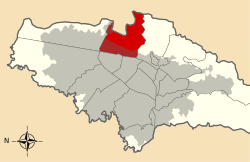Chapinero

|
|
| Basic data | |
|---|---|
| Surface: | 38.98 km 2 |
| location | 4 ° 39 ′ N , 74 ° 4 ′ W |
| Height above d. M .: | 2580 m |
| Population (2016): | 166,000 |
| Post Code: | 110211 (San Luis) 110221 (Chicó-Rosales) 110231 (Chapinero Central) |
| politics | |
| Department : | Bogotá |
| Structure: | Chapinero San Isidro Patios Pardo Rubio El Refugio Chicó Lago Barrios |
| Mayor: | Hernando José Quintero |
| Chapinero website | |
| location | |

|
|
Chapinero is the 2nd district ( localidad ) and one of the most important districts of the Colombian capital Bogotá . With an area of 3,899 hectares, Chapinero is one of the middle districts. A hundred years ago it was still a rural suburb, when Bogotá had just a few streets and a few thousand inhabitants who boasted of speaking the best Spanish in the world and who liked to call the town the "Athens of South America". In the second half of the last century, Chapinero became the residential area of the wealthy who moved from the run-down city center.
Meaning for Bogotá
Chapinero is one of the few districts that has been declared a zone of cultural interest in the city ("Zona de Interés Cultural de la Ciudad") because of its many sights. With the Museo del Chicó , the Plaza Parque and the Basilica of Our Lady of Lourdes as the center of Chapinero, as well as the Iglesia de la Porciúncula , these requirements are met. In addition, there are large shopping centers and a massive range of hotels of all classifications, in addition to the other hotels and private guest houses such as in neighboring Teusaquillo . Today the neighborhood, with its grand Victorian houses reminiscent of the old glory, is a swarm of street vendors selling fake sunglasses, DVDs and books, cheap restaurants advertised by pungent clowns with loudspeakers, and the ubiquitous, noisy bars.
Barrios
Chapinero is where most of Bogotá's most exclusive neighborhoods are; these are Los Rosales , La Cabrera , El Retiro , El Nogal and El Chico . This is where families and people with higher incomes traditionally live, who mainly settle in the north of the city.
nightlife
Today some of the city's most prominent spots are located here, such as the Zona Rosa with its nightlife (according to the newspaper El Tiempo , 90% of Bogotá tourists visit the area with prostitution and drug trafficking ) and its central meeting point, Parque de la 93 . It's Bogotá's favorite entertainment area. Because of the capital's active gay scene, the neighborhood is called "Chapigay" by the locals. Other bohemian neighborhoods are the area around Carrera Séptima to Avenida Caracas , as well as from Calle 45 to Calle 63. There are many bars, restaurants, supermarkets, shopping centers, parks and private clubs here. On Avenida Caracas between streets 54 and 56 is the so-called “La Playa”, where mariachi musicians can be found everywhere . In addition to the old town, most of the university facilities are located here.
Individual evidence
- ↑ On the move in Bogotá - A restless heart . faz.net. 30 November 2013
- ↑ Localidad de Chapinero . culturarecreacionydeporte.gov.co. Accessed March 10, 2017 (Spanish)
- ↑ On the move in Bogotá - A restless heart . faz.net. 30 November 2013
- ↑ Localidad de Chapinero bogota.gov.co. Accessed April 28, 2020 (Spanish)
- ↑ Las siete plagas que azotan la Zona Rosa . eltiempo.com. From October 5, 2014 (Spanish)
- ↑ Chapinero: The gayest neighborhood in Bogota . Latinamerica-reisemagazin.com. March 31, 2011
- ↑ Todo lo que se mueve detrás de La Playa Mariachi . civico.com. From July 14, 2014 (Spanish)
